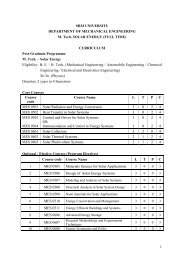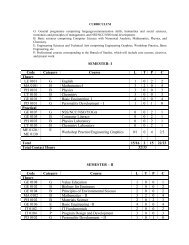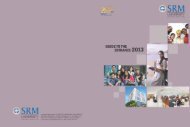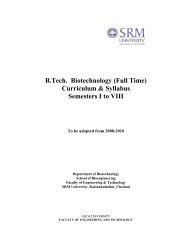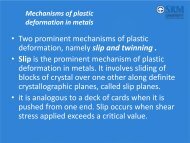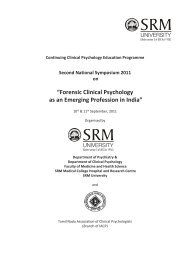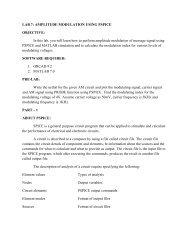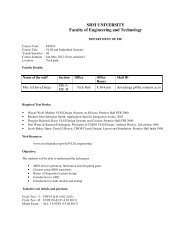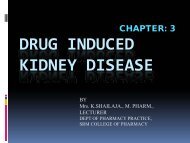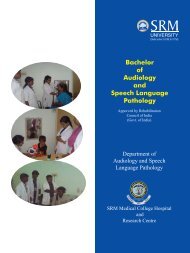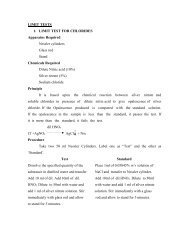PATHOLOGY OF MALARIA - SRM University
PATHOLOGY OF MALARIA - SRM University
PATHOLOGY OF MALARIA - SRM University
You also want an ePaper? Increase the reach of your titles
YUMPU automatically turns print PDFs into web optimized ePapers that Google loves.
Chapter 9<br />
<strong>PATHOLOGY</strong> <strong>OF</strong><br />
<strong>MALARIA</strong><br />
M.G.Rajanandh,<br />
Dept. of Pharmacy Practice,<br />
<strong>SRM</strong> College of Pharmacy,<br />
<strong>SRM</strong> <strong>University</strong>.
OVERVIEW<br />
• DEFINITION<br />
• EPIDEMIOLOGY<br />
• LIFE CYCLE<br />
• PATHOGENESIS<br />
• CLINICAL FEATURES<br />
• COMPLICATIONS<br />
• ORGAN CHANGES<br />
• Brain<br />
• Liver<br />
• Spleen<br />
• Kidneys<br />
• Heart<br />
• Lungs<br />
• GIT<br />
• Placenta
DEFINITION<br />
• This is an acute febrile illness caused by species<br />
of the genus plasmodia. This protozoan has 120<br />
species.<br />
• Infects about 100 million people at any one time<br />
globally.<br />
• Causes 1 million deaths globally annually.
Species<br />
• The most common pathogenic forms are:<br />
• P. falciparum; is the most common specie accounting<br />
for about 95% of infections.( Tropics and<br />
subtropics)<br />
• P. malariae; accounting for about 2-3% of infections<br />
(Tropics and subtropics).<br />
• P. ovale; accounting for another 1-2% of infections.<br />
(rare except in West africa)<br />
• P. vivax (not seen in Africa due to lack of Duffy<br />
antigen.
Epidemiology<br />
• Infection by falciparum malaria - severe<br />
economic consequences.<br />
• Globally about 1-2m death occurring annually<br />
due to falciparum malaria<br />
• 90% of deaths occur in sub-saharan Africa.<br />
• Efforts to eradicate malaria has made<br />
Mosquitoes (Anopheles) resistant to DDT and<br />
plasmodium resistant to Chloroquine and<br />
Pyrimethamine<br />
• Manifestation of malaria varies with endemicity<br />
of the disease
Endemicity<br />
• The endemicity -measured by spleen rates in<br />
children 75% and PR<br />
> 75%<br />
• Hyperendemic/highly endemic zone: SR & PR – 50 –<br />
74%<br />
• Mesoendemic zone: SR & PR – 11 – 49%<br />
• Hypoendemic zone: SR & PR -
Life cycle
Pathogenesis of P. falciparum 1<br />
Effects on the red cell<br />
• Central to the pathogenesis and pathology of<br />
malaria is the shortening of the lifespan of the<br />
red cell.
Metabolic changes within the<br />
RBC<br />
•Digestion of haemoglobin with<br />
utilization of glucose, oxygen and<br />
hemozoin formation.<br />
•Hypoxia stimulating lactate formation.<br />
•Free radical formation.<br />
•TNF is major mediator of the changes<br />
seen in severe malaria.
Pathogenesis/Pathophysiology<br />
• Alteration of the membrane transport system of<br />
the RBC<br />
• Decrease deformability of the RBC and increase<br />
susceptibility to sludging and destruction<br />
• Formation of knobs (from the rhoptery of<br />
mature schizonts) and protruberances on the<br />
RBC surface leading to formation of neoantigens<br />
with increased immune stimulation and<br />
increased vascular stickiness (ICAM & ELAM)<br />
and cytoadherance.<br />
• Presence of thrombospondin/CD46 which help<br />
in rosette formation.
Plasmodium falciparum<br />
• It infects RBCs of all ages (P vivax and ovale –<br />
young, P malariae –old)<br />
• Causes rosetting, sequestration – PfEMP1 binds<br />
to CD36, thrombospondin, VCAM-1, ICAM-1<br />
and E selectin<br />
• TNF, IFN-γ, IL-1 which suppress production of<br />
RBC etc
Antimalarial defence<br />
• Evolutionary – Survival<br />
• Inherited alterations in RBCs-<br />
HbS, HbC, lack of Duffy antigen<br />
Others - βThalasssaemia, G6PD, HLA Bw53 and<br />
HLA-DR
• General mechanism of antimalarial defence<br />
• Cellular and Humoral response<br />
• Stimulation of immune response<br />
Antibodies and T lymphocytes<br />
Antigenic variation of PfEMP1<br />
Parasite also reduces antigen presentation<br />
• Defence Mechanisms in Infants<br />
1 st 6 months is usually free of infection due to<br />
Transplacentally acquired immunity<br />
High conc of foetal Hb<br />
PABA in breast milk
Clinical features<br />
• Simple malaria<br />
• Severe/complicated malaria
• Severe normocytic anaemia (PCV
Complications
Splenic changes in Malaria<br />
• Spleen is enlarged and weighs about 500g during<br />
acute attack. It is soft and diffusely pigmented.<br />
• Upon repeated attacks the spleen is much larger<br />
and may exceed 1000g.<br />
• Microscopically there is congestion and reticuloendothelial<br />
hyperplasia.<br />
• Increased phagocytic activity of macrophages<br />
• Macrophage – engulfed parasites and RBC<br />
• Haemorrhages and infarcts may be present.
• Spleen from patients with chronic malaria are<br />
fibrotic with foci of mineralization (Gandy-<br />
Gamna bodies)<br />
• Brittle, thick capsule, fibrous trabeculae
Tropical Splenomegaly Syndrome<br />
(HIMSS)<br />
• Characterized by large spleen >1000g<br />
• Moderate anaemia,<br />
• High IgM level<br />
• Liver sinusoidal lymphocytosis.<br />
• Chronic low-grade malarial infection
Liver changes in Malaria<br />
• Liver is enlarged and has a slatey- gray<br />
appearance (hemozoin staining).<br />
• Kupffer cells are enlarged and contain malarial<br />
pigment, parasites and parasitized RBC.<br />
• Pigments are also found in parenchymal cells.<br />
• The sinusoids and other vessels are usually<br />
congested. Focal areas of fatty change may be<br />
seen
BRAIN<br />
• Cerebral oedema/congestion with pink<br />
appearance of the brain.<br />
• Petechiae in white matter<br />
• Features of raised intracranial pressure (grooving<br />
of uncal gyrus).
Microscopic features<br />
• Capillaries and venular congestion filled with<br />
parasitized RBC<br />
• Blockage of blood vessels by parasitized RBCs<br />
• Ring haemorrhages are characteristic.<br />
• Durks granuloma.
Kidney Changes in Malaria<br />
• Slightly enlarged<br />
• Malarial pigments in the glomeruli.<br />
• The cortico-medullary capillaries show<br />
parasitized RBCs and haemoglobin in<br />
tubules.<br />
• Acute tubular necrosis and Acute renal<br />
failure.<br />
• Quartan malarial nephropathy can occur in<br />
P. malariae infestation.<br />
• Blackwater fever
Heart<br />
• The heart may be dilated & flabby<br />
• There is pericardial/endocardial petechiae and<br />
congested capillaries containing parasitized RBC.<br />
• Focal hypoxic lesions<br />
• Focal interstitial infiltrates of the myocardium
Lungs<br />
• The lungs are congested and oedematous with<br />
occassonal parasitized erythrocytes in pulmonary<br />
capillaries.<br />
• Fibrin may be deposited in alveoli resulting in<br />
shock lung or ARDS.
GIT<br />
• Oedematous<br />
• Congested<br />
• Focal/diffuse haemorrhage.<br />
• Small vessels of the intestinal mucosa<br />
contain parasitized RBC<br />
• Massive sequestration and parasitisation of<br />
the GIT is sometime associated with<br />
vasomotor collapse resulting in the clinical<br />
syndrome of Algid malaria.
Malaria and Pregnancy<br />
• Malaria increases chances of foetal loss,<br />
pregnancy associated anaemia, IUGR and labour<br />
complications.<br />
• The placenta bed is markedly parasitized<br />
• In active disease -massive parasitization of the<br />
intervillous space<br />
• Old infection - peri-villous fibrosis and<br />
hemozoin deposition. Hemozoin takes some<br />
weeks to clear.
Parasitized RBC in placenta<br />
(IVS)
Diagnostic Pathology<br />
• Thick blood film helps in determining the<br />
density of infestation.<br />
• Thin film for specie determination.
Other Issues in Malaria<br />
• Congenital Malaria<br />
• Chloroquine resistant malaria<br />
• Control/eradication of malaria<br />
• Newer diagnostic techniques<br />
• National Policy on Malaria<br />
• National treatment guideline




